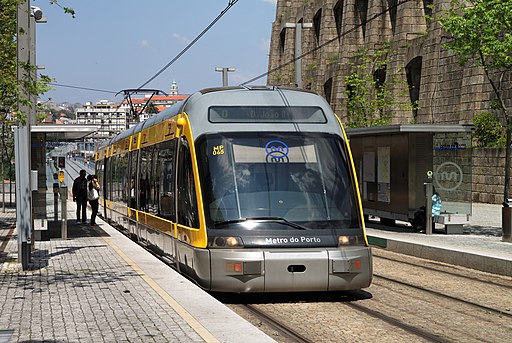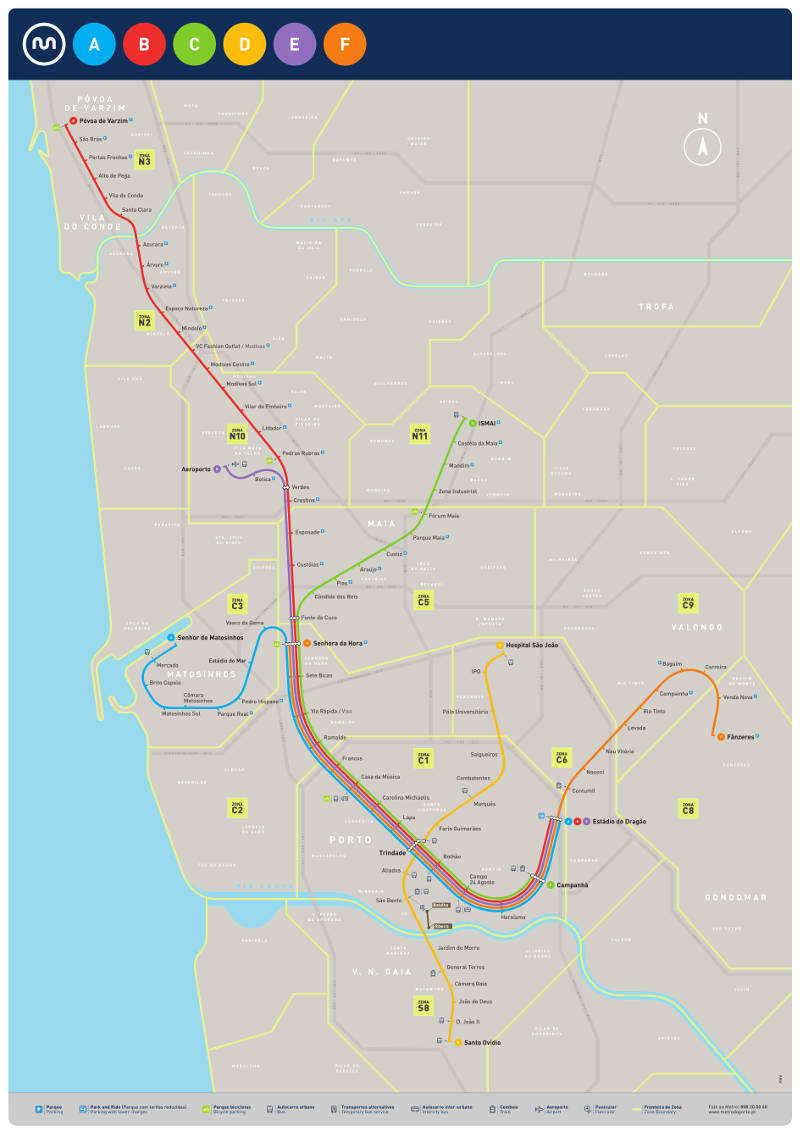Porto has a light rail transportation system that mostly resembles a tram. There are 6 lines, 81 stations and a 67-kilometer (42-mile) route.
The metro operates from 6:00 a.m. to 1:00 a.m. Fares are calculated by zone and a basic ticket is €1.20 ($US 1.36)
Service is available from the metro to the Francisco Sá Carneiro Airport.
Metros in Portugal: Porto Metro.
Porto has a light rail metropolitan transit system that mostly resembles a tram. However, it can be distinguished by the exclusive routes it serves and the streets solely accessible by its vehicles.
The system serves seven of the metropolitan’s municipalities. There are 6 lines extending 67 kilometers (42 miles) with a total of 81 stations. 14 are below ground.
The municipalities, accessible by the Porto Metro include: Porto in Zone C1, Gondomar in Zone C8, Vila Nova de Gaia in Zone S8, Póvoa de Varzim in Zone N°3, Matosinhos in Zone C3, Vila do Conde and Maia in Zone C5.
The Porto Metro operates for 18 continuous hours from 6:00 a.m. to 1:00 a.m. Train frequency is every 4 to 15 minutes, according to peak or non-peak hours.
Fares depend on the number of zones traveled. A basic ticket ranges from a minimum of 2 zones at €1.20 ($US 1.36) up to 12 zones at €5.20 ($US 5.85). Prices are reduced when reloading several trips on the Andante metro card.
The system provides service to and from the Francisco Sá Carneiro Airport, through a line that reaches the city center.
The Porto Metro’s operating partners are: The Metropolitan Area with 39.99% share, the Portuguese State with 40%, Public Transport Society of Porto with 16.67%, CP Caminhos de Ferro Protugueses E.P with 3.33% and Cámaras Municipales do Porto, V.N. Gaia, Matosinhos, Maia, Villa do Conde, Póvoa de Varzim and Gondomar.com with a 0.0005% share.
Lines and stations
The Porto Metro consists of 81 stations located along 6 lines. Each line is identified by a letter and a color. The central system’s main corridor is Trindade through which all the lines pass.
Line A:
This line is distinguished by the color blue and runs from Estádio do Dragão to Senhor de Matosinhos. It travels through Porto’s city center to Trindade and runs between Senhor de Matosinhos and Estádio do Dragão. There are 23 stations extending 15.6 kilometers (9.7 miles) The line is also known by the name Matosinhos. The route time is approximately 40 minutes and the train frequency is every 10 minutes.
- Line color: Blue
- Line number: A
- Line name: Estádio do Dragão - Senhor de Matosinhos
- Number of stations: 23
- Line length: 15.6 kilometers (9.7 miles)
- Total trip duration: 40 minutes
- Schedule: 6:00 a.m. to 1:00 a.m. Sundays to Thursdays (frequency 4 to 15 minutes), Fridays and Saturdays 24 hours (frequency 20 to 30 minutes)
Stations: Estádio do Dragão, Campanhã, Heroísmo, Campo 24 de Agosto, Bolhão, , Trindade, Lapa, Carolina Michaelis, Casa da Música, Francos, Ramalde, Viso, Sete Bicas, Senhora da Hora, Vasco da Gama, Estádio do Mar
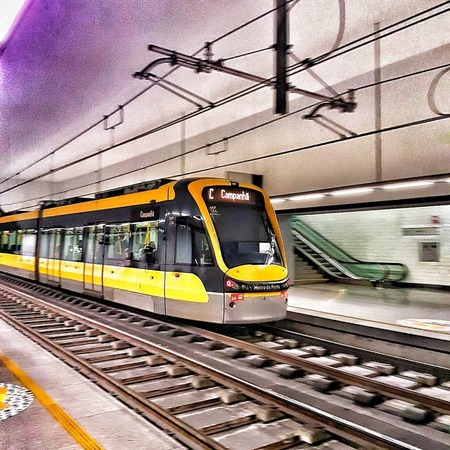 Campo 24 de Agosto
Campo 24 de Agosto
Line B
This line is distinguished by the color red and connects Estádio do Dragão to Póvoa de Varzim. It travels through the Do Condo region. There are 35 stations, covering 33.6 kilometers (20.9 miles). The total trip duration takes about 61 minutes.
- Line color: Red
- Line number: B
- Line name: Estádio do Dragão - Póvoa de Varzim
- Number of stations: 35
- Line length: 33.6 kilometers (20.9 miles)
- Total trip duration: 61 minutes
- Schedule: 6:00 a.m. to 1:00 a.m. Monday to Sunday.
Stations: Estádio do Dragão, Campanhã, Heroísmo, Campo 24 de Agosto, Bolhão, Trindade, Lapa, Carolina Michaelis, Casa da Música, Francos, Ramalde, Viso, Sete Bicas, Senhora da Hora, Fonte do Cuco, Custóias, Esposade, Crestins, Verdes, Pedras Rubras, Lidador, Vilar de Pinheiro, Modivas Sul, Modivas Centro, Modivas Norte, Mindelo, Espaço Natureza, Varziela, Árvore, Azurara, Santa Clara, Vila do Conde, Alto de Pega, Portas Fronhas, São Brás, Póvoa de Varzim
Line C:
This line can be identified by the color green and travels from Campanhã to ISMAI. It covers 19.6 kilometers (12.2 miles) and includes 24 stations. The total trip is 41 minutes and trains arrive every 15 minutes.
- Line color: Green
- Line number: C
- Line name: Campanhã - ISMAI
- Number of stations: 24
- Line length: 19.6 kilometers (12.2 miles)
- Total trip duration: 41 minutes
- Schedule: 6:00 am - 1:00 am, Monday – Sunday
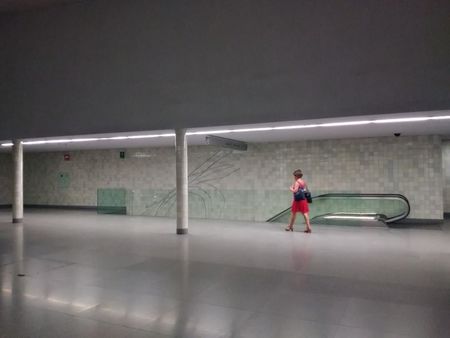
Stations: Campanhã, Heroísmo, Campo 24 de Agosto, Bolhão, Trindade, Lapa, Carolina Michaelis, Casa da Música, Francos , Ramalde , Viso, Sete Bicas, Senhora da Hora, Fonte do Cuco, Cândido dos Reis, Pias, Araújo, Custió, Parque Maia, Fórum Maia , Zona Industrial, Mandim, Castêlo da Maia, Ismai
Line D:
Distinguished by the color yellow, this line runs from Hospital São João to Santo Ovídio. It crosses the river from north to south. There are 16 stations extending 9.2 kilometers (5.7 miles) and the total trip takes about 25 minutes. The train frequency on Line D is every 6 minutes.
- Line color: Yellow
- Line number: D
- Line name: Hospital São João - Santo Ovídio
- Number of stations: 16
- Line length: 9.2 kilometers (5.7 miles)
- Total trip duration: 25 minutes
- Schedule: 6:00 a.m. - 1:00 a.m. Sunday – Thursday (frequency 4 - 15 minutes), Friday - Saturday 24 hours (frequency 20 - 30 minutes)
Stations: Hospital São João, IPO, Pólo Universitário, Salgueiros, Combatentes, Marquês, Faria Guimarães, Trindade, Aliados, São Bento, Jardim do Morro, General Torres, Câmara Gaia, João de Deus, D. João II, Santo Ovídio, Quinta do Cedro, Laborim, Hospital Santos Silva, Vila d'Este
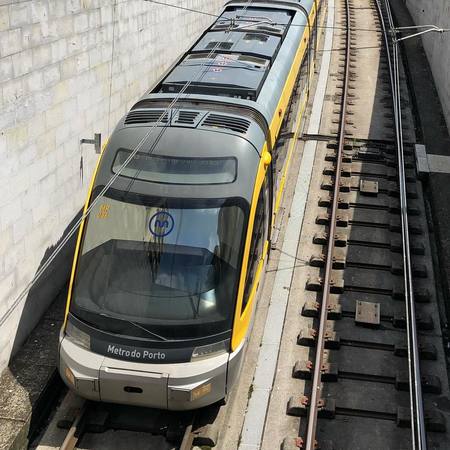
Line E:
Known as the Airport Line, this is distinguished by the color, violet and connects Estádio do Dragão station to the Airport. It is 16.7 kilometers (10.4 miles) and has 21 stations. The total trip lasts 35 minutes and each train arrives approximately every 30 minutes
.- Line color: Violet
- Line number: E
- Line name: Estádio do Dragão - Aeroporto
- Number of stations: 21
- Line length: 16.7 kilometers (10.4 miles)
- Total trip duration: 35 minutes
- Schedule: 6:00 a.m. to 1:00 a.m., Monday to Sunday
Stations: Estádio do Dragão , Campanhã, Heroísmo, Campo 24 de Agosto, Bolhão, Trindade, Lapa, Carolina Michaelis, Casa da Música, Francos, Ramalde, Viso, Sete Bicas, Senhora da Hora, Fonte do Cuco, Custóias, Esposade, Crestins, Verdes, Botica, Aeroporto
Line F
Line F is known as the Gondomar line and is identified by the orange color. It runs from Fânzeres to Senhora da Hora. It has 24 stations over a distance of 17.4 kilometers, and the entire route takes about 39 minutes. The frequency of the trains on this line is every 15 minutes.
- Line color: Orange
- Line number: F
- Line name: Fânzeres - Senhora da Hora
- Number of stations: 24
- Line length: 17.4 kilometers
- Total travel time: 39 minutes
- Operating hours: 6:00 am to 1:00 am from Monday to Sunday
Stations: Fânzeres, Venda Nova, Carreira, Baguim, Campainha, Rio Tinto, Levada, Nau Vitória, Nasoni, Contumil, Estádio do Dragão, Campanhã, Heroísmo, Campo 24 de Agosto, Bolhão, Trindade, Lapa, Carolina Michaelis, Casa da Música, Francos, Ramalde, Viso, Sete Bicas, Senhora da Hora.
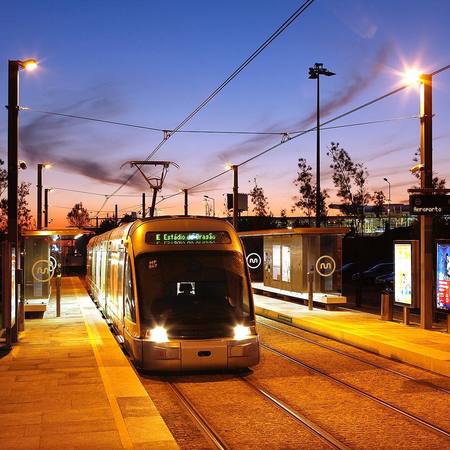 Metro do Porto
Metro do Porto
Funicular dos Guindais
The funicular railway travels from Batalha to Ribeira. There are only two stations along this 300-meter (984.3-mile) route. The trip is extremely short, just 3 minutes and the frequency is every 4 minutes.
Stations: Batalha, Ribeira
Schedule and Frequency
Trains operate from 6:00 a.m. to 1:00 a.m. from Sunday to Monday. However, on Fridays and Saturdays, the metro partners with the program, Move Porto and the schedule expands to 24 hours on Lines A (Blue) and D (Yellow).
Train frequency is every 4 to 15 minutes, depending on customer demand.
Connections
Connections between lines:
Below are the connections that can be made on Line A (Blue):
- Estádio do Dragão station to Line B (Red), Line E (Violet) and Line F (Orange)
- Campanhã station to Line C (Green) and the Comboios de Portugal (CP), historically known as Caminhos de Ferro Portugueses.
- Trindade station to Line D (Yellow)
- Senhora da Hora station to the four connection options of Line B (Red) Line C (Green), Line E (Violet) and Line F (Orange)
Below are the connections that can be made on Line B (Red):
- Estádio do Dragão station to Line A (Blue), Line E (Violet) and Line F (Orange)
- Campanhã station to Line C (Green) and the Comboios de Portugal (CP) railway
- Trindade station to Line D (Yellow)
- Senhora da Hora station to Line A (Blue) and Line F (Orange)
- Fonte do Cuco station to Line C (Green)
- Verdes station to Line E (Violet)
- Campanhã station to Line A (Blue), Line B (Red), Line E (Violet), Line F (Orange) and the Comboios de Portugal (CP) railway
- Trindade station to Line D (Yellow)
- Senhora da Hora station to Line A (Blue) and Line F (Orange)
- Fonte do Cuco station to Line B (Red) and Line E (Violet)
- Trindade station to Lines A (Blue), B (Red), C (Green), E (Violet), and F (Orange)
- São Bento station to the Comboios de Portugal (CP) railway
- General Torres station to the Comboios de Portugal (CP) railway
- Estádio do Dragão station to Lines A (Blue), B (Red), and F (Orange)
- Campanhã station to Line C (Green) and to Combois de Portugal (CP) railway
- Trindade station to Line D (Yellow)
- Senhora da Hora station to Line A (Blue) and Line F (Orange)
- Fonte do Cuco station to Line C (Green)
- Verdes station to Line B (Red)
- The Airport station to the Francisco Sá Carneiro Airport
- Campainha station to the Comboios de Portugal (CP) railway.
- Contumil station to the Comboios de Portugal (CP) railway
- Estádio do Dragão station to Lines A (Blue), B (Red) and E (Violet)
- Campanhã station to Line C (Green) and the Comboios de Portugal (CP) Railway
- Trindade station to Line D (Yellow)
- Senhora da Hora station to Lines A, B, C and E
- Blue Andante Card : This reloadable metro card is for the occasional rider. The cost varies according to the number of zones traveled and can be reloaded for 1 to 30 trips. The ticket costs €0.60 (US 0.69) and the trip price ranges from two zones at €1.20 ($US 1.37) up to €5.20 ($US 5.94) for 12 zones.
- Andante Tour Card : This blue Andante card can also be used on 24-hour modes of transportation for €7 ($US 7.99). The 72-hour card is €15 ($US 17.12). The tour card can be purchased at metro and STCP (Sociedade de Transportes Colectivos do Porto) stations, Andante shops, the airport and the Office of Tourism.
- Occasional Andante Park & Ride - €0.95/12hr day ($US 1.08)
- Signature Andante Park & Ride - €17.00 /monthly [12hr day] ($US 19.4)
- A ticket should be purchased prior to boarding the metro and failure to do so will result in a fine of €77 ($US 87.86).
- Trains and platforms are equipped to facilitate use by disabled and vision-impaired riders, including individuals with color blindness who need assistance selecting the appropriate route.
- Bicycles are permitted within designated areas of the train to avoid disturbing other passengers.
- The Porto Metro system is electric, with an energy saving brake technology of 30%.
- Each vehicle’s maximum speed is 80 kilometers per hour (49.7 miles per hour) and more recent models reach 100 kilometers per hour (62.1 miles per hour). They are 35 meters (114.8 feet) and can hold up to 80 seated passengers. Additional space is available for passengers in wheelchairs.
- Trains have air conditioning, a sound system and destination and station indicators in both the exterior and interior.
- Instead of rear-view mirrors, there are overhead cameras in the cabinets that conductors control from their monitors.
- In 2017, the Porto Metro surpassed its record of 60 million customers.
- The Porto Cathedral built in the thirteenth century
- The Clérigos Church: Built in baroque style with 225 steps leading to its 75-meter (246-foot) high tower
- The Pálacio de la Bolsa: Built in the mid-nineteenth century in neoclassical style with an extensive Arab Room inspired by the Alhambra in Granada
- The Museum of Contemporary Art: 13,000 square meters (139,931 square feet), composed of granite and stucco and containing contemporary works of art
- Serralves Park: The city’s green space, filled with gardens, greenhouses and farm animals
- Playa de Matosinhos: The beautiful beach where people skate, play and enjoy a large variety of restaurant options
- The Porto shopping center: Filled with shops and cafes
- The Lello and Irmao bookstore: Located on Rua de las Carmelitas Nº144 and famous for being the inspiration for some Harry Potter scenes
- Line D Yellow : Polo Universidad - OPI - Hospital de San Juan
- Line C Green : Fórum Maia - ISMAI
- Line B Red : Pedras Rubras -Póvoa de Varzim
Below are the connections that can be made on Line C (Green):
Below are the connections that can be made on Line D (Yellow):
Below are the connections that can be made on Line E (Violet):
Below are the connections that can be made on Line F (Orange):
Connections to other systems
The stations that provide connections to other systems include Campanhã, São Bento, and General Torres with the Comboios de Portugal (CP) railway and the Airport station to the Francisco Sá Carneiro Airport.
Prices, tickets and passes
The Porto Metro ticket system is multipurpose and offers access to all the city’s transportation systems.
This is a contactless chip card (riders can simply pass through entry points with it in their baggage, rather than taking the card out to be scanned). A basic ticket covers two zones and costs €1.20 ($US 1.37).
Occasional Trips
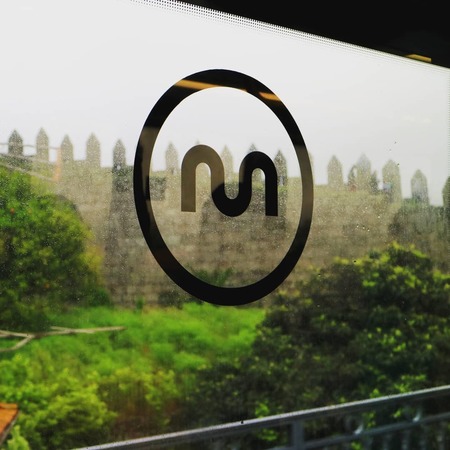
Frequent trips
Monthly subscription - Andante Card: Designed for frequent travelers, this card is personalized and can be reloaded according to the number of areas or zones that the rider frequents. It can be reloaded at both terminals and automated machines.
The system also offers discounted tickets to low-income families, people age 65 or over, and students of primary, secondary, and intermediate to high-level vocational technical schools.
Metro Parking
The Porto Metro offers a daily Park & Ride service that can be used for up to 12 hours with an Andante ticket.
The parking fee options vary at the Metro Park/Estádio del Dragáo Park & Ride interface station.
Without the use of public transportation, the cost is €0.30 ($US 0.34) for every 15 minutes.
If the daily limit of 12 hours is exceeded, there is an additional cost of €0.30 ($US 0.34) for every 15 minutes.
Although Metro Park gates are open from 5:30 a.m. to 1:00 a.m., 24-hour parking is available. Customers may enter and exit at any time by using the intercoms available on the entrance ramps.
Gates at the Metro Park Estádio do Dragáo close 3 hours prior to the start of soccer matches on weekdays. Gates close four hours prior to matches on weekends and holidays. Entrance to the parking area is prohibited during these times.
Rules, tips and warnings
Notable facts
Future expansions
In January 2018, plans emerged to add four subway stations and extend the Pink (G) line 2.5 kilometers (1.6 miles). A Yellow Line extension to connect Santo Ovídio and Vila d'Este stations to reach the Hospital de Gaia, is also planned. 3 new stations at an additional 3.2 kilometers (2 miles) is expected as well.
Construction is expected to begin in early 2019 and to be complete by 2022. The new lines will meet major demands on both sides of the city and provide daily service to 33 thousand people.
The overall investment for this expansion phase is about 290 million euros.
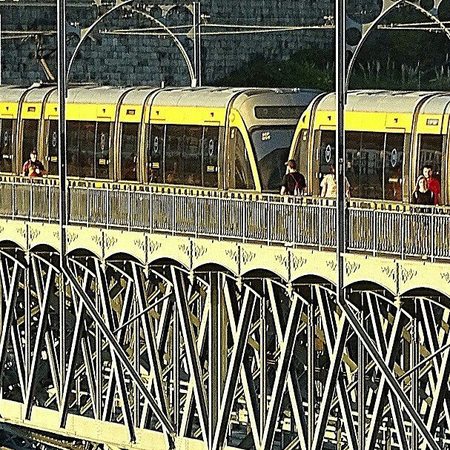 Porto
Porto
Airport connection
The Porto Metro connects to the Francisco Sá Carneiro Airport.
Getting to the airport
Since May 27, 2006, the Metro’s Violet Line has provided a quick, direct connection between the city center and the airport. (It connects both direct and indirectly to all system destinations as well).
The trip from the airport to this line’s main destinations, the Casa da Música station and the Trindade Station take 22 minutes and 27 minutes respectively. Without transfers, the Andante Z4 card, used for these trips, costs €1.85 ($US 2.10).
 Casa da Musica metro station
Casa da Musica metro station
Service is available every day of the year. The schedule operates from 6:00 a.m. to 1:00 a.m. and trains run about every 20 minutes, depending on the schedule and influx of passengers.
Sightseeing via the Porto Metro
The Porto Metro is the perfect answer to touring the city. Including the monuments, major museums, show halls, buildings symbolic of the city, traditional businesses, the best local restaurants and nightlife, the city’s main attractions are easily accessible from the train.
Among the places, characteristic of Porto, is the São Bento Railway Station, where the Convent of São Bento del Avé Maria was constructed at the beginning of the ninth century. Here, one can enjoy over 20,000 titles portraying Portugal’s history.
One can take a train to the vineyards or to some of the region’s beautiful towns, among which are Guimaraes, Braga and Viana do Castelo.
Declared a UNESCO World Heritage site, this historic city center is accessible from the Porto Metro
Other metro accessible sites, characteristic of Porto, include:
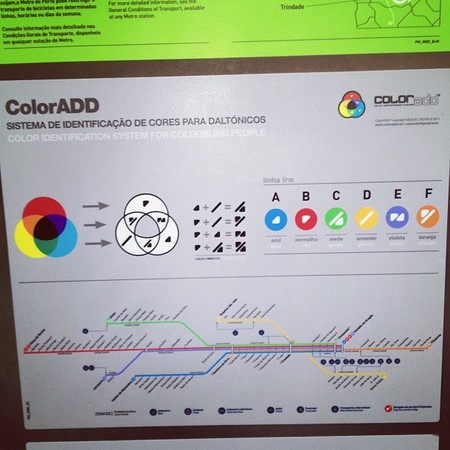
Milestones of the Porto Metro construction
The international public tender for design, system construction, equipment and operation was launched in 1994 and the light rail system began operating in 2002.
Between 1994 and 1999, the approval phase of the network, awarding of contracts, approval of credits and other legal aspects were fulfilled. The first official shipyard installation in Campanhã was completed and the process of shareholder restructuring was finalized in 1999.
The metro underwent constant growth between 2002 and 2011. Below is a list of its major milestones.
Period 2000 - 2002
Construction was accelerated and in 2002, an experimental phase was carried out that allowed at least 700 thousand residents to take part in the first test trips, free of charge. These tests were completed over the course of 19 weeks along routes that totaled 100 thousand kilometers (62,137 miles). The blue line was inaugurated on December 7, 2002.
2003
Commercial operation began on the blue line in January 2003, and according to March records, just a few months later, the system reached one million riders.
Construction on the Yellow Line (D) in Vila Nova de Gaia also began in March and Ponto do Infante was opened. The yellow line was the sixth to be completed, covering the route over Duero River between Porto and Vila de Gaia.
In the third quarter of 2003, excavation of the Trindade/Bridge and Salgueiros/Trindade tunnels was completed and the Council of Ministers approved the Gondomar Line, the Boavista Line and an extension to Porto International Airport.
2004
In December 2004, the blue line completed its second year of operation with a record number of 9.8 million riders, a 65.2% increase from 2003.
The opening of the Funicular dos Guindais created a connection from the riverside area of Ribeira to Batalha. The European Union Cohesion Fund approved the airport link project between Francisco Sá Carneiro and the Varzim line, that consists of a double track connection between the light rail metro system and the trans-European network.
The Blue Line (A) is extended between Trindade and Estádio del Dragáo with the opening of the stations, Bolhão, El Campo 24 de Agosto de Heroísmo, Campanhã and Estádio do Dragão.
Commercial operation of Line D (Yellow) is connected between Câmara de Gaia and el Polo Universitário stations.
Line C (Green) is opened between Estádio do Dragão and Fórum Maia.
2005
Line B (Red) is opened between Estádio do Dragão and Pedras Rubras station, making up 23 kilometers (14.3 miles) and allowing access to the Maia municipality.
Construction begins on Line E (Violet) to connect the Francisco Sá Carneiro International Airport to Estadio del Dragáo. This would make Porto the second Iberian city to connect the metro to the airport.
2006
Opening of the following sections:
2007
On June 13, 2017, the Porto Metro received the International Union of Public Transport’s award for “Best New Light Rail System in a ceremony held in Istanbul.
2008
The new D. João II station in Vila Nova de Gaia on the Yellow Line (D) is inaugurated, making a total of 70 stations on the massive transportation system.
2009
Construction begins on the Orange Line between Estádio del Dragáo and Fânzeres in March.
2010
The Subconcession contract is signed for the operation and maintenance of the light rail metro system in the Porto metropolitan area. This was to be administered for five years by the ViaPorto Consortium.
2011
The Santo Ovídio station is opened on the Yellow Line (D) on October 15.
2011
The Orange Line (F) is inaugurated in January.
2017
On February 7, approval is announced for new connections on the Pink Line between Casa de la Música and San Benito and the expansion of the Yellow Line to Villa D'Este.
Porto Metro Map
Map via www.metrodoporto.ptSee map full resolution. It may take a little bit to load.
Download map.
Some other metro maps of Oporto
Porto Metro Plan
- Also Known As: Metro do Porto
- Passengers/Day 150000
- Fares: honour system
- 24h operation: No
- Air Conditioning: Yes
- Walk between platforms: Yes
- Driverless trains: No
- Screen Doors Platforms: No
- Average Speed: km/h
- Max. Speed: 100km/h
- Operator: Via Porto
- 1.1€
- Oporto Metro Official Website
- Tlf: 225 081 000
Help us
If you consider that the information we provide is wrong, not accurated, outdated, translation contains errors, and you would like to help us to improve the file...you can contact us here.
Feel free to contact us if you dont find the system you're looking for and we'll add it as soon as we can!
Thank you very much!







